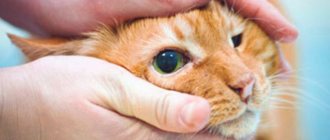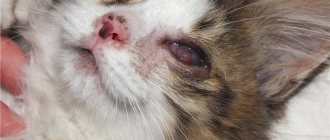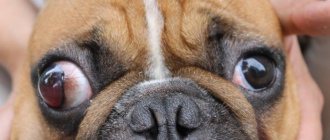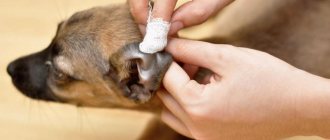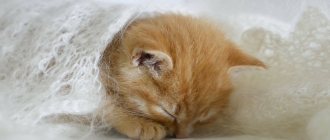There are all sorts of situations, and it’s better to find out in advance how to do it correctly and what means you can use, than to rush around in a panic at a difficult moment.
Moreover, there is nothing complicated in this procedure and absolutely anyone can cope with it.
Causes and symptoms of eye diseases
Most often, an animal's eye waters for a trivial reason - a tiny speck has gotten into it and the cat's body is trying to remove it in this way. Most likely, you won’t have to intervene here: a few hours and the problem will be solved naturally.
But often the reasons are more serious. We list them below:
Injury (wound, scratch, cut) received during a fall, play or fight. The cornea turns red, the mucous membrane swells, and bleeding may occur.- If a foreign body gets into the eye, severe lacrimation will first occur, gradually the cornea and eyelid will turn red, and pus will appear.
- The cause of blepharitis (inflammation of the eyelids) is an untreated wound in the mucosal area that has become infected. This often happens to cats walking outside: if you scratch your eye with a dirty paw, a problem arises. The eyelids swell, cloudy mucus flows from the eye.
- Eversion or inversion of the eyelid, keratitis, conjunctivitis occurs with severe burns, due to the ingress of a foreign body or exposure to chemicals. The mucous membrane and cornea turn red, the cat hides from the light, tears flow from the eyes.
- Parasitosis is unexpected, but true: some types of parasites (Thelazia californiensis, Thelazia callipaeda) settle not only in the fur or intestines, but also in the eye area: between the eyelashes, under the eyelids, in the cornea itself. The first symptoms include conjunctivitis, itching, loss of eyelashes and hair around the eyes, clouding of the cornea, ulcers on the cornea, and fever. Only a specialist can remove worms and their larvae, and the owner can also wash the eyes with antibacterial drugs.
- In infectious diseases, the entire body may be affected (for example, chlamydia or plague) or the focus will be concentrated in the eye. Symptoms vary: lacrimation, the appearance of a tumor, crusts on the eyelids, etc.
- A cat may be allergic to: poplar fluff, perfume or household chemicals, pollen, etc. The eyelids turn red, clear, odorless mucus flows from the eyes.
- The anatomical features of some cat breeds (rexes, sphinxes) provoke health problems. This also applies to the eyes.
Prevention
It is necessary to prevent infectious diseases. First of all, you need to get all the necessary vaccinations for your four-legged friend. Don't forget to check on your pet from time to time. And it will never be superfluous to visit the veterinarian’s office for preventive purposes.
To avoid injury to the animal, supervise it while walking. And if your pet is prone to inappropriate behavior, walk him on a harness. Remember right away that if a cat’s eye festers after a fight, there is nothing to be surprised about. There is obvious damage to the organ by debris or the claws of the enemy. If any situation does lead to damage to the eye, do not delay with first aid, treat the affected area as soon as possible. Regarding how to wash a cat’s eyes if they fester, everything is simple - you can use boiled water or a herbal decoction.
Don’t forget about such an item as deworming. Worms cause double harm to the animal. In addition to the main parasitic factor, helminths harm the animal by poisoning it with the products of their vital activity. And if a cat’s eye is watery and purulent, this is one of the signs of an allergic reaction caused by the activity of worms.
If for any reason the animal injures the area near the eye, take measures to ensure that the pet does not scratch the affected area. An Elizabethan cat collar works well for this purpose. If desired, you can do it yourself.
If you have a long-haired cat at home that is prone to eye infections, trim the hair around her eyes - this will be a good preventive measure and a possible panacea for unwanted discharge.
In general, if you are interested in knowing why a cat’s eyes fester, first of all think about how caring you are towards your pet:
- do you vaccinate it;
- anthelmintic;
- carry out preventive examinations.
After all, timely care of the animal and care for minor injuries help to avoid many complications, including problems affecting the cat’s eyes.
Cautions
If the disease is serious, you cannot do without consulting a veterinarian. Only a specialist can prescribe appropriate medications and procedures based on your medical history and test results.
Otherwise - if street dust gets into the cat's eyes, for example - you can do a simple cleansing yourself. But remember a few important rules:
Not all water can be used for this.
There is definitely no tap water - the bleach and salts contained in it dry out the mucous membrane and destroy the natural microflora. In addition, such water may be contaminated. Rain and melt water are also not suitable. The liquid must be boiled and cooled!- Instead of cotton wool, use cotton pads: this is the only way to be sure that small fibers will not get under the eyelid and cause additional problems.
- For each eye - a new tampon, for each procedure - a fresh decoction.
- You cannot use chamomile infusion - it causes cats to lose hair.
- Rinse solutions should be warm, not hot or cold.
- If days go by and there is still no result, take your cat to the doctor.
Additional Tips
Once you've adopted a kitten or cat, get them used to the process so they don't find it weird when you do it regularly. If your cat has long hair, try trimming it around the eyes. Little do you know, their corneas can be scratched by their own hair!
Besides, your cat is the most unpredictable, impulsive creature. It's always best to keep an eye on them. If you'll be gone for long hours, make sure there's at least someone to keep an eye on them. Always have someone help you when cleaning your cat's eyes, as they move around a lot and won't want to cooperate with you in this process.
If the crusty, mud-like appearance continues to appear no matter how many times you clean it a day, they will need professional medical attention. Also, if you see that your cat has trouble opening its eyes or there is swelling after you have cleaned the eyes, immediately take him to the nearest veterinarian for further examination.
How to wash a cat's eyes?
If, after reading the title, you imagined expensive drugs - exhale, calm down and look in your home medicine cabinet. We assure you: you can always find something suitable there.
Medicines
Of the human medicines for washing cat eyes, you can use:
- isotonic solution 0.9% (saline) - is one of the most important components of tissue fluid and plasma, due to which it does not irritate the skin and mucous membranes of animals;
- Furacilin solution (0.02%) - is an antibacterial drug for external use (you can buy tablets and prepare the solution yourself);
- boric acid solution - dissolve 1 small spoon of powder in a glass of warm water;
- chlorhexidine (it is better to take a concentration of 0.01%) - a cheap product with a good bactericidal effect;
- potassium permanganate solution (1:5000).
The list is small, but it is not recommended to use other drugs without a veterinarian’s prescription: problems with intolerance or dosage calculation may arise.
Stick to dosages strictly! The slightest mistake can lead to irreversible consequences: severe chemical burns and even blindness. If your animal develops allergy symptoms, stop using the product immediately and show the animal to a doctor!
Pet stores sell special products for cats:
Diamond Eyes drops are antibacterial drops for topical use.
Relieves swelling and inflammation, destroys bacteria. Contains: succinic acid, taurine, chlorhexidine bigluconate, purified water. Contraindications: individual intolerance. Compatible with other medications.- Drops "Bars" - contain nitrofural and chloramphenicol. They have a bactericidal and bacteriostatic effect, cope with certain types of viruses, and relieve pain. Contraindications: allergy to components.
- Drops "Iris" - an analogue of "Bars". Gentamicin sulfate (base) has a pronounced bactericidal effect.
- OPHTO-LAVAS is a sterile eye cleansing solution. Do not allow the drug to come into contact with the skin of the animal.
Folk remedies
It is not always possible to find a suitable drug in a home medicine cabinet. In such a situation, you can use time-tested folk methods. Here are some examples:
- Lime tea. Pour 75 ml of boiling water over a small amount of linden flowers, let it brew for half an hour, filter with gauze and rinse the animal’s eyes.
- Elderberry leaves. Grind 10 g of elderberry leaves, pour boiling water over it, cover with a lid and leave in a saucepan for 40 minutes. The resulting liquid can be used to wash your eyes 3-6 times a day.
- Infusion of celandine. Helps with excessive purulent discharge from the eyes, pain and redness. Finely chop a few fresh celandine leaves (4-6), brew 5 ml of boiling water and leave for 15 to 25 minutes. Place the infusion in your eyes (and in healthy eyes too).
- Black tea. You can only use yesterday's tea leaves, which have been brewed for 10-12 hours. Soak cotton pads in the liquid and apply to the cat's eyelids for a few seconds. At least six such procedures must be performed per day. Sugar or other sweeteners must not be added!
- Decoction of chamomile, St. John's wort, hyssop. If your cat's eyelids stick together, prepare a decoction of 1 tablespoon of any herb and a glass of boiling water, let it brew for 10 minutes, strain, moisten a piece of gauze and wash the animal's eyes 2-3 times a day.
- Aloe. Not the pulp, but aloe juice removes pus and relieves inflammation. Grind 2-3 leaves in a blender into porridge, strain the juice. Instill 1 drop 2 times a day: morning and evening.
- Yarrow decoction. Pour 10 g of the collection with a glass of boiling water, leave for half an hour, strain and rinse the mucous membranes of the eyes 2-4 times a day.
Features of the procedure
Whether a cat requires treatment or a kitten, there are no significant differences in treatment procedures.
In both the first and second cases, accuracy and calm are required. Animals, not understanding what is happening to them, begin to get nervous, fidget and may even try to bite.
To make the process safer, you can use a special bag-retainer (these are sold in pet stores), or an ordinary thick blanket in which you can wrap the cat, leaving only its head free.
Materials you will need:
- sterile gauze or cotton pads;
- clean towel or cloth napkins;
- syringe or pipette;
- the drug itself.
In adults
- It will be great if you involve an assistant in the matter. He will be able to fix the animal in the desired position, and you will calmly and without distraction carry out all the necessary manipulations. The animal is placed in a retaining bag or wrapped in a blanket, hiding its paws and claws away.
- Wash your hands thoroughly with soap.
- Dry crusts in the corners of the eyes or on the eyelids should never be peeled off - only soaked and carefully peeled off little by little. Ordinary clean water will help soften them: moisten a cotton swab generously, press it to the eye and hold, and when the crusts become noticeably softer, slowly peel them off. Do not pour water into your cat's eyes unnecessarily, do not rub the cornea, and follow a line from the ears to the nose along the tear duct. Use a separate clean pad for each eye.
- If during rinsing you notice foreign, indelible particles lying on the surface of the eye or in the folds of the conjunctiva, do not touch them and do not try to remove them yourself, immediately run to the doctor!
- Are your eyes clear? Excellent: you can wash it with medicine. To do this, use either a regular human pipette, a syringe, or a 20 ml syringe (without a needle, of course). Spread the eyelids with two fingers (index and thumb) and drip the solution into the upper outer corner of the eye: this way the solution will thoroughly wash the entire cornea and conjunctival sac. The remaining solution is blotted with a napkin or towel.
Do not rub the cornea with a cloth, do not press on it - this can cause grass to the animal.
In kittens
Unlike adults, kittens cannot perform a full toilet until a certain age: their mother cat takes care of them for a long time and the babies need time to get used to doing everything on their own.
Therefore, if problems begin with the kittens’ eyes, and the mother cat is not nearby, you will have to deal with it yourself. Proceed in the same way as with adult animals. But even more care and attention is needed, because kittens’ eyes are smaller and more vulnerable than those of adults.
You don’t need to involve an assistant here: you can handle the baby yourself. The most convenient time is after sleep, when the baby has not yet played out, or before bed. You cannot carry out the procedure immediately after eating - the kitten may vomit.
If, in addition to cleansing rinses, you will also need to apply ointments, wait 10 minutes after the procedure. This minimizes the risk of mucosal irritation.
If you have never washed your animal’s eyes and, in general, be afraid to carry out any medical procedures - contact your nearest veterinary clinic. They will take a little money for this, but they will do everything quickly and carefully, and they will also give useful advice for the future.
How to properly treat a kitten's eyes
The duration and course of the disease depends on the careful implementation of the procedures prescribed by the veterinarian. There is no need to do it on your own, you just need to follow the doctor’s instructions.
If the kitten's eyes and muzzle are covered with crusts, they should be softened using Vaseline. The next stage of daily care is washing with antiseptic solutions or herbal decoctions.
- Place the animal on its back with its muzzle up, fix the position so that the baby does not kick. If the kitten struggles and scratches, you can wrap it in a towel.
- Prepare two bowls with the medicinal solution: one for the right eye, the second for the left. This precaution is necessary to prevent the infection (bacteria) from spreading. Gently drop the product into your left eye using a pipette, and then use a sponge soaked in the same solution to wipe your eyelids. Do not press hard on the eyeball, move from the outer corner of the eye to the inner.
- Perform the same manipulation for the right eye, using the contents of the second bowl.
- Do not place the dropper too close to the eye, as this may cause injury to the kitten. Each eye is wiped twice in one procedure. The course of treatment is usually 7-10 days.
After cleansing, the eyes are instilled, slightly pulling the eyelid. The kitten must blink so that the medicine is evenly distributed over the eyeball. If necessary (as prescribed by a doctor), apply the ointment according to the following scenario:
- place the animal on its side so that its muzzle “looks” up;
- lift the lower eyelid and apply a little ointment (usually tetracycline);
- massage the eyelid so that the drug is distributed;
- treat the other eye;
- course of treatment up to 10 days.
If you conscientiously perform all the procedures prescribed by the doctor, the kitten will recover quickly!
